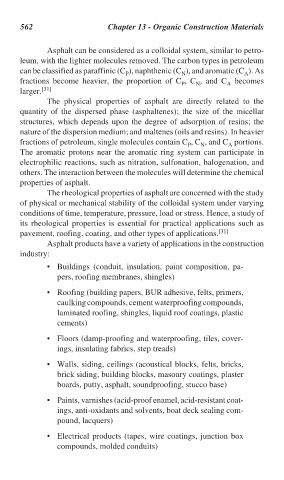Page 595 - Handbook of Thermal Analysis of Construction Materials
P. 595
562 Chapter 13 - Organic Construction Materials
Asphalt can be considered as a colloidal system, similar to petro-
leum, with the lighter molecules removed. The carbon types in petroleum
can be classified as paraffinic (C ), naphthenic (C ), and aromatic (C ). As
P
N
A
fractions become heavier, the proportion of C , C , and C becomes
P N A
larger. [31]
The physical properties of asphalt are directly related to the
quantity of the dispersed phase (asphaltenes); the size of the micellar
structures, which depends upon the degree of adsorption of resins; the
nature of the dispersion medium; and maltenes (oils and resins). In heavier
fractions of petroleum, single molecules contain C , C , and C portions.
P
N
A
The aromatic protons near the aromatic ring system can participate in
electrophilic reactions, such as nitration, sulfonation, halogenation, and
others. The interaction between the molecules will determine the chemical
properties of asphalt.
The rheological properties of asphalt are concerned with the study
of physical or mechanical stability of the colloidal system under varying
conditions of time, temperature, pressure, load or stress. Hence, a study of
its rheological properties is essential for practical applications such as
pavement, roofing, coating, and other types of applications. [31]
Asphalt products have a variety of applications in the construction
industry:
• Buildings (conduit, insulation, paint composition, pa-
pers, roofing membranes, shingles)
• Roofing (building papers, BUR adhesive, felts, primers,
caulking compounds, cement waterproofing compounds,
laminated roofing, shingles, liquid roof coatings, plastic
cements)
• Floors (damp-proofing and waterproofing, tiles, cover-
ings, insulating fabrics, step treads)
• Walls, siding, ceilings (acoustical blocks, felts, bricks,
brick siding, building blocks, masonry coatings, plaster
boards, putty, asphalt, soundproofing, stucco base)
• Paints, varnishes (acid-proof enamel, acid-resistant coat-
ings, anti-oxidants and solvents, boat deck sealing com-
pound, lacquers)
• Electrical products (tapes, wire coatings, junction box
compounds, molded conduits)

